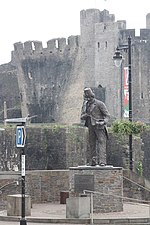Caerphilly Mountain
CaerphillyClimbs in cycle racing in the United KingdomCommon land in WalesMountains and hills of Caerphilly County BoroughWales geography stubs

Caerphilly Mountain (Welsh: Mynydd Caerffili) lies between Cardiff and Caerphilly at the southern edge of the South Wales Coalfield. Its summit is 271 metres (889 ft) above sea-level.Since 1957 there had been a small wooden snack bar near to the summit. In September 2011 this was replaced by an eco-friendly permanent building, with under floor heating, solar panels and rainwater-flushed toilets, at a cost of £300,000. The mountain includes Caerphilly Common (Welsh: Comin Caerffili). The climb features regularly on the Tour of Britain cycle race, with double climbs in the 2012 and 2013 races.
Excerpt from the Wikipedia article Caerphilly Mountain (License: CC BY-SA 3.0, Authors, Images).Caerphilly Mountain
Mountain Road,
Geographical coordinates (GPS) Address Nearby Places Show on map
Geographical coordinates (GPS)
| Latitude | Longitude |
|---|---|
| N 51.56228 ° | E -3.22334 ° |
Address
Mountain Road
CF83 1HL , St Martins
Wales, United Kingdom
Open on Google Maps









